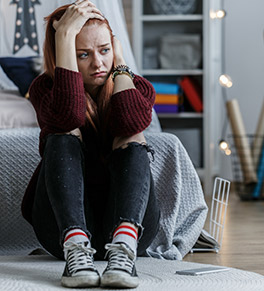A mental health crisis engulfs kids

Parents need to be alert to changes in their child's behavior and be prepared to get help if needed, advises UCI Health child and adolescent psychiatrist Dr. Elliot Handler.
The number of children in need of treatment for mental health issues has increased dramatically in Orange County and the nation as young people have been cooped up in their homes throughout the COVID-19 pandemic, unmoored from familiar social structures and routines.
During 2020 alone, the number of U.S. mental health-related emergency department (ED) visits among children ages 12 to 17 increased 31% compared with 2019, according to the U.S. Centers for Disease Control and Prevention (CDC).
The vast majority of these are related to suicidal thoughts or attempted suicides, says Dr. Elliot M. Handler, a UCI Health psychiatrist who specializes in child and adolescent psychiatry. For example, in May 2020, two months into the pandemic, ED visits for suspected suicide attempts began to rise nationally among these adolescents, especially girls.
“Compared even to last year, we are seeing more suicidal thinking as well as attempts,” says Handler, an assistant professor of psychiatry and human behavior at the UCI School of Medicine. “We are making more referrals than ever to intensive outpatient programs and for inpatient hospitalizations.”
‘COVID-19, the common denominator’
Child psychiatrists used to see seasonal increases in problems — typically when school starts and during final exams. Over the last year, children experienced far more difficulties over longer periods of time, Handler says. And it’s taking longer for children to get help and to get better.
“Although it has been rare for patients to cite COVID-19 as the only factor,” he says, “it seems to be the common denominator for everyone.”
The pressure is certainly strongest on adolescents and teens, but Handler has seen suicidal or hopeless thinking in children as young as 6 or 7 years of age. Factors may include financial hardship, loss of social outlets, decreased physical activity and living in close quarters with family members.
Handler says family conflict is a significant contributor in many pediatric mental health issues. Having to quarantine in a highly contentious home environment has led to a significant increase in the severity of child abuse reports during the pandemic. Simultaneously, there has been a decrease in the total number of child abuse reports, since teachers have typically been the ones to make these reports when they observed changes in student behavior or other subtle signs of abuse in the classroom.
“In the hospital, it seems like we have been making daily calls to Child Protective Services during the pandemic,” he says.
How we got here
The sudden shift to online learning and limits on outdoor activities upended existing routines and social structures for children as well as adults.
“Structure, socialization and leisure are all protective against suicidal thoughts,” says Handler.
“But these have all taken an enormous hit during the pandemic. Without school, sports and extracurricular activities, kids lost the structures of their lives that had them getting up at the same time each day, going to bed at the same time — basically keeping the circadian rhythm on a schedule.”
Psychiatrists call this behavioral activation, which is both protective against depression as well as a therapy for the condition.
New challenges
With many students returning to in-person classes, kids face new challenges, including coping with COVID-19 safety measures and rusty social skills, in addition to the normal stresses common for each age group.
Adolescents, for example, are in the process of forming their identities, figuring out who they are as individuals, what they believe and where they fit in, most often separate from their family. School, sports, clubs and cliques have historically been a place for this exploration.
Now, however, teens are finding themselves thrust back into intense peer-group situations with social skills that are unpracticed at best. Because children derive so much of their sense of self from interacting with peers, if they’re not integrating well, it can lead to despair, anguish and suicidal thought.
Coping with COVID-19 fears and safety measures may also be difficult, especially given that there is no vaccine approved for children ages 11 and under. When parents and kids don’t see eye-to-eye on how to approach these challenges, the strain can be enormous for a child. When parents don’t believe in vaccinations or masks — or even make fun of their kids for wanting to wear a mask — it can leave kids feeling anguished that their parents don’t care about their health.
Signs to watch for
Children may exhibit fear and distress at times throughout their development. They also may feel sad or hopeless occasionally. But when these feelings persist and affect their behavior, it may indicate an anxiety disorder or depression, according to the CDC.
Signs of serious anxiety may include:
- Fear of being apart from parents (separation anxiety)
- Fear of being in public places, including school (social anxiety)
- Fear about the future and bad things happening (general anxiety)
- Bouts of sudden, intense fear accompanied by a pounding heart, trouble breathing, dizziness or excessive sweating (panic disorder)
Indicators of depression include:
- Feeling sad, hopeless or irritable much of the time
- Disinterest in doing fun things they used to enjoy
- Eating a lot more or a lot less than usual
- Sleeping a lot more or a lot less than normal
- Changes in energy levels, such as feeling tired, sluggishness, tense or restless a lot of the time
- Difficulty paying attention or concentrating
- Feeling worthless, useless or guilty
- Self-destructive or self-harming behaviors
Act on safety concerns
Handler says it’s important to take your child’s state of mind seriously and pay attention to them.
Even before the pandemic, nearly 20% of U.S. teens thought about suicide — with higher percentages among girls (24.1%), white non-Hispanic students (19.1%), students who reported having sex with persons of the same sex or with both sexes (54.2%), and students who identified as lesbian, gay or bisexual (46.8%), according to the CDC's 2019 Youth Risk Behavior Survey.
Parents need to seek emergency help if they have an immediate concern for their child’s safety. Red flags may include statements of wanting to be dead or self-harming — like cutting — that is new or has increased in frequency or severity.
Ways to help your children cope with our new reality and keep the lines of communication open include:
- Be curious about who your children are. If you talk with them, they’ll find it’s easier to talk with you. When your kids say something about how they’re feeling, listen and take it seriously.
- Get them on a structured schedule that includes engaging in physical activities and leisure pursuits within moderation.
- Watch for significant behavioral changes, such as increased isolation, sleeping problems, changes in appetite, irritability, loss of interest in things they genuinely used to enjoy and now no longer gain pleasure from.
- Take care of yourself and ask for help if needed. Children look to adults as behavioral models and if they see their parents struggling, not asking for help, that’s the lesson they take away.
If you are seeing significant behavioral changes, seek an appointment with a trained therapist or a psychiatrist, Handler advises. “Prevention and surveillance are key. If it turns out there is an issue, you’ll be thankful you caught it.”
For kids who may be hesitant to meet with a therapist, let them know that a single appointment isn’t a commitment to longer term treatment, but rather a way to make sure that they’re getting their needs met.
‘Have a little hope’
Children and adolescents are facing a multitude of challenges as they try to get back to a semblance of normal life, but Handler believes returning to school and regular activities is best.
However, if there are real and serious safety concerns related to the pandemic, families should make choices that make sense based on their values and risk tolerance. For those who choose online instruction in the near term, it is still a good idea to think about when it would be appropriate to re-integrate children to in-person learning.
“Fear is the only thing that shrinks as you get closer to it,” he says. “Kids can overcome so much hardship. Stable footing, support and encouragement can make it that much easier for them to succeed. Let’s all have a little hope.”
Explore further
Browse more blog posts by topic.




